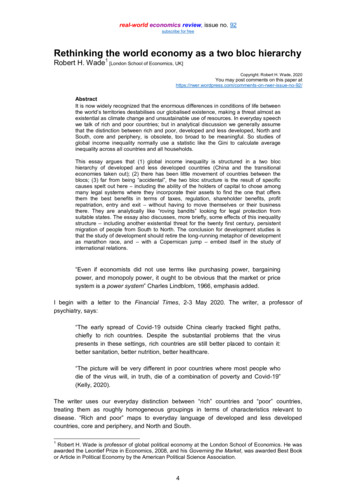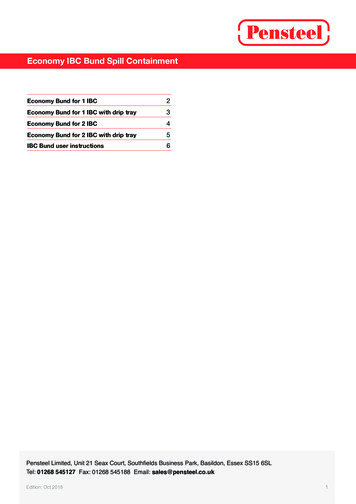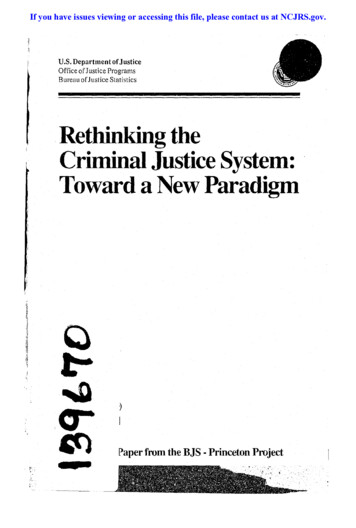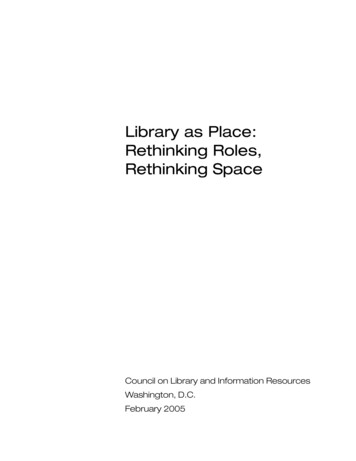
Transcription
real-world economics review, issue no. 92subscribe for freeRethinking the world economy as a two bloc hierarchyRobert H. Wade1 [London School of Economics, UK]Copyright: Robert H. Wade, 2020You may post comments on this paper e-no-92/AbstractIt is now widely recognized that the enormous differences in conditions of life betweenthe world’s territories destabilises our globalised existence, making a threat almost asexistential as climate change and unsustainable use of resources. In everyday speechwe talk of rich and poor countries; but in analytical discussion we generally assumethat the distinction between rich and poor, developed and less developed, North andSouth, core and periphery, is obsolete, too broad to be meaningful. So studies ofglobal income inequality normally use a statistic like the Gini to calculate averageinequality across all countries and all households.This essay argues that (1) global income inequality is structured in a two blochierarchy of developed and less developed countries (China and the transitionaleconomies taken out); (2) there has been little movement of countries between theblocs; (3) far from being “accidental”, the two bloc structure is the result of specificcauses spelt out here – including the ability of the holders of capital to chose amongmany legal systems where they incorporate their assets to find the one that offersthem the best benefits in terms of taxes, regulation, shareholder benefits, profitrepatriation, entry and exit – without having to move themselves or their businessthere. They are analytically like “roving bandits” looking for legal protection fromsuitable states. The essay also discusses, more briefly, some effects of this inequalitystructure – including another existential threat for the twenty first century, persistentmigration of people from South to North. The conclusion for development studies isthat the study of development should retire the long-running metaphor of developmentas marathon race, and – with a Copernican jump – embed itself in the study ofinternational relations.“Even if economists did not use terms like purchasing power, bargainingpower, and monopoly power, it ought to be obvious that the market or pricesystem is a power system” Charles Lindblom, 1966, emphasis added.I begin with a letter to the Financial Times, 2-3 May 2020. The writer, a professor ofpsychiatry, says:“The early spread of Covid-19 outside China clearly tracked flight paths,chiefly to rich countries. Despite the substantial problems that the viruspresents in these settings, rich countries are still better placed to contain it:better sanitation, better nutrition, better healthcare.“The picture will be very different in poor countries where most people whodie of the virus will, in truth, die of a combination of poverty and Covid-19”(Kelly, 2020).The writer uses our everyday distinction between “rich” countries and “poor” countries,treating them as roughly homogeneous groupings in terms of characteristics relevant todisease. “Rich and poor” maps to everyday language of developed and less developedcountries, core and periphery, and North and South.1Robert H. Wade is professor of global political economy at the London School of Economics. He wasawarded the Leontief Prize in Economics, 2008, and his Governing the Market, was awarded Best Bookor Article in Political Economy by the American Political Science Association.4
real-world economics review, issue no. 92subscribe for freeWhat is strange is that our main sources of data about the world economy hardly use thisbreakdown into two big polarized groupings.1. Statistical and theoretical occlusion of the north-south dualismIn 2010 the president of the World Bank, Robert Zoellick, declared the distinction betweendeveloped and developing countries to be obsolete.“If 1989 saw the end of the ‘Second World’ with Communism’s demise, then2009 saw the end of what was known as the ‘Third World’. We are now in anew, fast-evolving multipolar world economy – in which some developingcountries are emerging as economic powers; others are moving towardsbecoming additional poles of growth; and some are struggling to attain theirpotential within this new system” (Zoellick, 2010).The World Bank often uses a four-fold classification by average income: high incomecountries; upper middle income countries; lower middle income countries; and low incomecountries – with fairly arbitrary US dollar thresholds. It also uses categories like “Poor andIndebted”, and “Poor, Struggling, Converging, and Affluent”. And various geographicalcategories like “Middle East and North Africa”.The IMF identifies “Advanced Countries” (a category which includes the ones commonlyunderstood to be developed/the North/the core); and for the rest, categories that blendgeographical and development criteria, such as “Emerging Developing Europe” and “MiddleEast, North Africa, Pakistan, Afghanistan”.What we don’t find from these organizations is data which illuminates the internal coherenceof North and South and the size and trend in gaps between them. That inattention in turnsustains the core mainstream understanding that less developed countries are in thatcategory because of their delay in adopting fully capitalist institutions and policies – WaltRostow’s The Stages of Economic Growth (1959) being a famous early example.The ur-image is development as a marathon race: all runners could conceivably cross thefinish line at the same time, and their finishing order reflects differences in conditions internalto each runner; there is no structure to the race such that some run faster on account of thefact that some run slower.Globalization theory, which became “hegemonic” in the 1980s, turbo-charged thisunderstanding, with its implication that less developed countries can (eventually) catch up,each on their own, by adopting fully capitalist institutions and policies in the image of thedeveloped countries. Globalization theory is a sub-set of neoliberal theory, which advancesan agenda of low taxes, low public spending, and capital and labour free to be bought andsold in global markets, because this freedom will maximize material prosperity and liberty forall.Three quotes bring out the core idea. First, a New York Times journalist covering the 2002World Economic Forum meeting summarized the prevailing wisdom among the Davos elite:“A nation that opens its economy and keeps government’s role to a minimum invariablyexperiences more rapid economic growth and rising incomes” (Uchitelle, 2002).5
real-world economics review, issue no. 92subscribe for freeSecond, Martin Wolf, distinguished columnist for the Financial Times and author of WhyGlobalization Works, declared:“It cannot make sense to fragment the world economy more than it already isbut rather to make the world economy work as if it were the United States, orat least the European Union . The failure of our world is not that there is toomuch globalization, but that there is too little. The potential for greatereconomic integration is barely tapped” (Wolf, 2004: 4).Third, John Williamson, who coined the phrase and gave the content of the WashingtonConsensus, asserted: “in the long run, countries’ progress is primarily dependent on their ownefforts rather than on the [passive] international environment” (Williamson, 2004:197).The northern states – and the international organisations they largely control – givefinancial aid and technical assistance to developing countries in order, they say, to reduce thedelay in the latter adopting fully capitalist regimes, with conditionalities in line with theWashington Consensus about “best practice” institutions and policies. For example, the WorldBank has long deployed the Country Policy and Institutional Assessment (CPIA) formula toscore countries by the “goodness-for-development” of their policies and institutions, and thenfactors the score into its lending decisions and country dialogues. The scoring criteria for thetrade regime imply that a completely free trade regime is best for development. The criteriafor labour markets give the highest score to countries with maximum employer flexibility andminimum worker security (Wade, 2010).And in fact, “globalization” has vastly increased over the past several decades. World traderose from 39 per cent of world GDP in 1990 to 58 per cent in 2018. International assets andliabilities rocketed from 128 per cent to 401 per cent of GDP. On both measures the world isfar more integrated than it was in 1914, the last peak of globalization (Economist, 2019). Yetthe promised catching-up of the South has barely occurred, except for a short period fromaround 2002 to 2012, when fast growth in the South was driven mainly by surging Chinesedemand for commodities. (For purposes of the statistical comparison of the two blocs, theSouth excludes China and the transitional economies.)The Swahili proverb says, “Until the lions have their own historians the history of hunting willalways glorify the hunters”. The mainstream’s explanation for the slowness of catching-up –due to slowness of southern governments and businesses to adopt the institutions andpolicies of advanced capitalism – illustrates history being written, rules set, by the winners. Itis in line with what could be called a “law” of modern-era power hierarchies: elites legitimizetheir success in terms of universalistic and meritocratic qualities, like initiative, hard work,commitment to the scientific method, and legitimize others’ lower rank in terms of their failureto match these qualities, their excessive dedication to identity politics, corruption, leisure (andwhite populations have long used the non-universalistic criterion of skin colour to claimsuperiority). In Max Weber’s words from 1915:“The fortunate man is seldom satisfied with the fact of being fortunate . Heneeds to know that he has a right to his good fortune. He wants to beconvinced that he ‘deserves’ it in comparison with others . [G]ood fortunethus wants to be legitimate fortune” (emphasis added).6
real-world economics review, issue no. 92subscribe for freeIn short, the mainstream view of development does not see the world economy in terms oftwo encompassing and hierarchically-ordered blocs, with internal coherence and withmechanisms ( instrumental and structural ) linking them which tend to sustain the hierarchy.And not just the mainstream; many analysts who consider themselves broadly on the left andsympathetic to the idea of “combined and uneven development”, originally coined by Trotsky,also consider that the developed/less developed distinction too broad to be meaningful.This essay aims to bring out the internal coherence of the two blocs and the mechanisms thattend to perpetuate the hierarchy. It suggests that seeing the world order in this way helps usto understand many contemporary trends as -- in part -- effects of the two bloc structure: suchas the persistence of high levels of national (vertical) inequality, immigration from South toNorth, rise of illiberal democracies in North and South, northern countries’ wars in the South,and more. The shift in perspective is akin – if a slight exaggeration be permitted – to the jumpCopernicus made in formulating a model that placed Sun rather than Earth at the center ofthe universe.2. Indicators of the North-South dualityHere are several indicators of the North-South duality.2.1 How much catch-up?First, an impressionistic measure of the Great Divergence : the number of non-westerncountries that have become “developed” in the past two centuries. The number depends onhow broadly we categorize “non-western”, “countries”, and “developed”. Even stretching themout (to include Russia as non-western, Hong Kong as a country), we get maybe seven:Japan, Russia, Hong Kong, Taiwan, South Korea, Singapore and Israel. This “fact” should bebut is not front and center to the whole discipline of “development studies”.Notice that most of the countries had small populations during their fast-industrializationphase, and also one or more powerful external enemies threatening the state’s existence.The common threat produced a “fellowship of the lifeboat”, without which state incumbentsmight have taken a more cavalier approach to defrauding the state and used their power tosuppress opponents (“enemies”) rather than promote a national development project able tocreate a unified- enough polity to dissuade an external enemy. And Japan, Taiwan, SouthKorea and Israel – four of the seven – received very large amounts of American financial,technical and military aid in the post-war decades to keep them firmly within the USgeopolitical orbit; while Hong Kong was an outpost of British rule and British business until1997 (Wade, 2019).Another pointer to low upward mobility comes from a World Bank study (2013), which findsthat in 1960 there were 101 “middle-income” countries, using the Bank’s absolute incomethresholds in US dollars. Only 13 had risen to “high-income” by 2008, four on the periphery ofwestern Europe, five in East Asia. Most of them have populations less than 20 million; they2account for an insignificant fraction of the world’s population.2Cherif and Hasanov (2019) take 182 countries and classify them by the percentage of their averageincome relative to that of the US in 2005, and cut the distribution at 50% of US average income to givethe threshold of “high income”. They find that between 1970 and 2014 only 13 out of 148 low and middle7
real-world economics review, issue no. 92subscribe for free2.2 The North-South income gap across timeThe size of the income gap across time can be measured by the ratio of the North’s averageGDP to the South’s GDP. GDP is measured at market exchange rates, not at purchasingpower parity exchange rates, because the former gives a more accurate measure of theability of residents of a country to buy goods and services in other countries, and hence is abetter measure of relative structural power in the inter-state system (Wade, 2017, Box 12.1).Alan Freeman (2020) defines the ratio of the North’s GDP per capita in market exchange3rates to that of the South as the Monetary Inequality Index (MII).The MII has risen substantially from 1950 till today, meaning that the North-South gap haswidened substantially. From 1954 to 2000 it rose three times, from 7 to 21, and especially fastduring the 1980s (coinciding with the full-force application in the South of the WashingtonConsensus liberalisation recipe). Then it fell from 21 to around 11 in 2012, when it flatted outand started to rise again. This fall in MII – or “catch up” for the South in ability to purchasegoods and services from the North – was the effect of the commodity price boom forcommodity exporters largely to China, which raised southern “price times output” growth rateswell above those in the North, but locked the South more firmly into commodity specialization.Another gap measure is the density distribution of global employment by value-added perworker or per hour. This too shows a pronounced two hump structure. The high labourproductivity hump covers the North, with about 15% of world employment, the low labourproductivity hump covers the South, with around 60-70 of world employment (here includingChina) (Gomulka 2006).Another measure of the North-South gap: the average income of the wealthiest quartile of thepopulation of the South ( 8,700 in 2015) was only about a quarter of that of the poorestquartile of the North ( 30,400).2.3 Internal income coherenceThe two blocs are relatively coherent in terms of their internal income distribution, in thesense that within the blocs, inter-country income inequality is much less than between theblocs. Countries of the North have converged together in GDPPC over 1970-2015, and notconverged with the South.Drawing again on Alan Freeman (2020), we can divide the South into six geographicalregions: “East Asia of the South” (excluding Northeast Asia and Singapore), Pacific, SouthAsia, Middle East and North Africa, Sub-Saharan Africa, and Latin America and Caribbean.Over almost half a century, from 1970 to 2016, the average incomes of these southernregions remain within 50% and 250% of the average of the South, with no region “breakingfree” towards the North and no trend towards divergence within the South. The averageincome rank order in 2016 was: Latin America and Caribbean, Middle East and North Africa,East Asia of the South, Pacific, and Sub-saharan Africa equal with South Asia. Over the halfcentury from 1970, East Asia of the South rose in the rank order, and Sub-saharan Africa fell.income countries reached the high income threshold; of which 6 peripheral Europe, 3 tiny oil exporters,and 4 East Asian. (They use PPP 2011, Penn World Tables 9.0).3My account of the income gaps draws heavily on Freeman 2020.8
real-world economics review, issue no. 92subscribe for freeThe others kept the same rank order in 2016 as in 1970. A remarkable continuity. The gapbetween the six regions is smaller than the gap between them and the North.2.4 Income inequality between North and South in relation to global income inequalityIncome inequality between North and South (average income of both at market exchangerates) accounts for most of the inequality between all countries. And income inequalitybetween countries accounts for more of global income inequality (between all peopleregardless of country) than income inequality within countries. Inter-bloc inequality (now fourblocs: North, South, China, transitional economies) contributes between 4 and 7 times moreto global inequality than intra-bloc inequality, over the whole period from 1970 to 2015(Freeman 2020).2.5 ConclusionThe bottom line is that North and South are coherent blocs in important ways. The incomegap between the North-South blocs is – persistently – larger than the income gaps withinthem. If we plot the share of world population living in countries arranged by average incomewe see a pronounced bimodal distribution, with not much population in between.Countries of the North enjoy common economic benefits from their superior position in theworld hierarchy, making for common interests in protecting their position from challengers.They translate common interests into political treaties, such as free trade agreements (e.g.NAFTA), political federations (eg European Union), and security agreements (eg NATO); andinto common agreements linking groups of northern countries with regions of the South (e.g.Lome Convention, a trade and aid agreement between the European Economic Commissionand 71 African, Caribbean and Pacific countries, signed in 1975). The seven leadingeconomies of the North have concerted their actions through the G7 summits, claiming to bethe top table of governance for the world (though not replacing the UN Security Council onsecurity issues); and supported by tiers of other G7 coordination forums.Countries of the South have broadly similar income levels and are subject to broadly similarpressures from the world economy. But they are much less organized in collective actionorganizations than countries of the North – whether regional or cross-regional (e.g. G77, andG24 which coordinates developing countries in the World Bank and IMF, with a tiny budget).For example, the Chiang Mai Initiative was created after the Asian financial crisis of 1997-99to organize currency swaps within Northeast and Southeast Asia, so as to reduce the relianceon emergency financing from the western-dominated IMF. But it has barely functioned, owingpartly to deep suspicion between the two countries with the biggest foreign exchangereserves, China and Japan (Wade 2013).We can see the North-South difference in the contrast between G7 and G20. The G7 includesonly the major northern economies, which share high rank in GDP and in GDP per capita,with a correlation coefficient of around 0.7 – suggesting strong common interests andrelatively high ability to concert their actions. The G20 (formed at finance minister level afterthe Asian financial crash of 1997-99 and at summit level after the North Atlantic financialcrash of 2008-09) includes 11 developing countries, and the corresponding correlationcoefficient is around 0.3 – suggesting much less common interest among the member states(Vestergaard and Wade, 2012a; 2012b).9
real-world economics review, issue no. 92subscribe for free3. Effects of the North-South dualismThe North-South dualism is the starting point for understanding key trends:1) high and/or rising inequality in the North, as cheap labour in the South puts downwardpressure on wages in the North;2) high and/or rising inequality in the South, as southern elites aim for northern eliteconsumption levels. (Milanovic [2019] reports that the average income of the bottomfive percent of Chile equals the bottom five percent of Mongolia, one of the poorestcountries in the world; the average income of the top two percent in Chile equals theaverage of the top two percent in Germany);3) migration waves from South to North, which roil the politics of the North;4) shift towards “illiberal democracy”, “identitarian politics” in the North as right-wingpolitical leaders build support on the back of voters’ “left-behind” grievances byblaming migrants, Jews, Muslims or still Others for shortages of housing, health careand employment;5) reinforcement of authoritarian rule and repression in the South as elites defendagainst social unrest fuelled by relative deprivation, amped up by social mediaimages;6) the main states of the North act semi-concertedly to prevent or selectively channel therise of countries of the South, which might challenge the market and technologicaldominance of northern corporations and challenge the ability of northern states to setglobal agendas. The North-South income hierarchy looks pleasing and “natural” to theNorth, as Max Weber would expect. Some of the techniques used to split the Southand hinder upward income mobility of most of its members include: war (think Iraq,2003); economic sanctions; anti-communist rhetoric to camouflage actions to blockeconomic/technological challenges from the South; and the economic liberalizationplus poverty focus of the Washington Consensus.4. Mechanisms of structural power of North over SouthThe techniques just mentioned are techniques of “instrumental” power used by northernstates to restrain the rise of the South. I now turn to the mechanisms of “structural” power bywhich the hierarchy came into existence and is sustained. Structural power is the kind ofpower that business gets over states when it can exit from a jurisdiction whose governmentintends to do something business does not want, something that curbs its profits; or when thegovernment actually does it and then faces a capital exit, with a hit to employment, incomes,and tax revenue, inducing the government to back off. Structural power is also the power theIMF has over heavily indebted countries (what we in the North commonly call “the Asiancrisis” of 1997-99 is commonly called “the IMF crisis” in South Korea). China gets structuralpower over many countries which depend heavily on export revenues from China, includingAustralia and New Zealand. The Chinese government doesn’t need to warn them belligerentlynot to criticise China’s revanchism in the South China Sea or repression in Xinjiang, and notto hinder its influence campaigns in Australian and New Zealand politics (Brady 2017). As ofthe past few years, however, the Australian government has pushed back, leading to frequentflare-ups.10
real-world economics review, issue no. 92subscribe for free4.1 OriginLet us start with the origin of the modern core-periphery or North-South system. From beforethe Industrial (Energy) Revolution the northern countries have typically tried to preventdeveloping countries from entering or remaining in dynamic sectors or segments of valuechains with increasing returns to scale, limiting them to sectors with diminishing returns toscale; they recognized, as neoclassical economists did not, that economic development isactivity-specific. Building the skill- and linkage-intensive activities within the national territory iswhat being a structurally dominant country is all about.During colonial times, actors in the European colonial project – governments, militaries,companies – created dependent colonial and slave economies to which they outsourced landintensive production. This structure delivered an “agricultural windfall”, which allowed labourat home to be used for industrialization and provided an export market for manufactures. TheBritish government or its agents ensured that British colonies or dependencies – by the earlytwentieth century accounting for an area 125 times the area of Britain, about one quarter ofthe Earth’s habited area and almost a quarter of its population, the biggest empire in worldhistory by far – specialized in commodity production for export to the core. For example, soonafter the English government conquered Ireland by 1691 it closed down the prosperous Irishwoollen industry; and the British East India Company closed down production of cottontextiles in its (effective) colony of Bengal in the early nineteenth century, so that Bengalifarmers exported raw cotton to the textile mills of Manchester. Textiles was thetechnologically leading sector of the day – relatively capital intensive, with economies ofscale, learning economies, linkages to other sectors, and demand for organizationalinnovations (e.g. factories).No nation of size became developed without a coercive system of this kind and/or aprolonged Listian phase of infant industry protection (after Friedrich List, The National Systemof Political Economy, 1841). And once a nation was at or near the frontier of development, itswitched to articulating a simplified version of Adam Smith and “free trade for all” (Reinert1994). The English economist-financier-politician David Ricardo (1772–1823) developed thetheory of comparative advantage and the derived policy of free trade to legitimize such aswitch for all. In his famous example, if England specializes in textiles and Portugal in wineand they trade their surpluses, they can each consume more of both than if they both producetextiles and wine. He forgot to mention that this gave England the sector with skillrequirements and growth potential and Portugal the one with stagnation, and that Englishfamilies owned a good part of Portugal’s wine exporting business.Generations of mainstream economists have subscribed to the theory of comparativeadvantage and the policy of free trade on grounds not much more sophisticated than this; andespecially after the neoliberal turn in the 1980s, have urged developing countries to practicefree trade with memes like “Why throw rocks in your own harbour?” Recall the Swahiliproverb, and Max Weber on the drive to make good fortune legitimate fortune.The globalization literature tends to slight the point that the dramatically increased marketintegration in the past several decades has occurred in the context of a hierarchicallystructured world economy, in which northern countries have more activity in increasing return,high profit, high wage activities, and able to set the rules to give themselves competitiveadvantages and generous rewards of profits and rents (Wade, 2003a; 2003b).11
real-world economics review, issue no. 92subscribe for freethStarting from the structure of the 19 century world economy, path dependence andcumulative causation along well-institutionalized power relations have produced “combinedand uneven” development between the two blocs over the past several decades, throughmechanisms including the following:First, the tendency for supply to exceed demand in the core (a point emphasized by theclassical economists and later by John Maynard Keynes), making the North dependent on theSouth as a source of demand for its industrial, service and agricultural exports.Second, the North’s dependence on imports of natural resources and cheap-labourmanufactured goods from the periphery.Third, the core’s dependence on people of varying skill levels coming to work there.Fourth, the tendency for the periphery to run trade and current account deficits, financed bycredit from the core (and by aid, foreign investment, and US spending on military bases,around 700 in 130 countries in 2003, according to Defence Department reports: Johnson2004). The deficits reflect the high-income elasticity of demand for industrial and serviceimports in the periphery and typically lower income elasticity of demand for commodities inthe core. The periphery’s foreign debt – which must be repaid in reserve currencies, generallyUS dollars (Africa’s foreign debt is 70 per cent denominated in US dollars) – easily risesabove its capacity to repay, resulting in debt traps, followed by emergency loans from corecontrolled international organizations and core banks freighted with tough neo-liberal –privatizing and market-opening – conditionalities.Fifth, the tendency to deficits and debt traps is part of a larger tendency to highly volatilegrowth in the periphery, resulting from (a) dependence on commodity exports, (b)dependence on tourism and remittances, and (c) easy entry and exit of capital from the North.Dependence on commodity exports has been higher since the 1990s than before, because of“premature de-industrialization”. Commodity prices and capital inflows to the South arestrongly correlated, yielding twin booms and twin busts; and stronger in recent decadesbecause large financial firms have come to dominate commodity markets (Akuz 2020).Aiyer at al. (2013) find that middle-income countries tend to experience more volatile growththan either low- or high-income countries, with periods of super-fast growth (GDP growth at 6per cent a year or more) followed by protracted slowdowns. Indeed,
trade regime imply that a completely free trade regime is best for development. The criteria for labour markets give the highest score to countries with maximum employer flexibility and minimum worker security (Wade, 2010). And in fact, "globalization" has vastly increased over the past several decades. World trade











